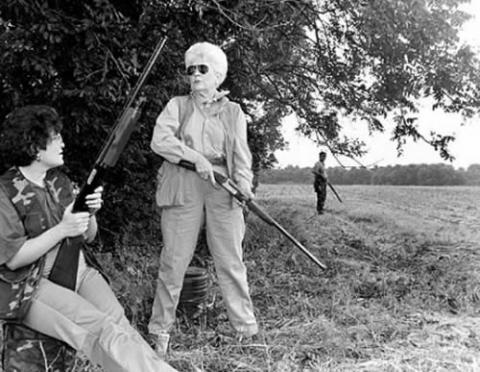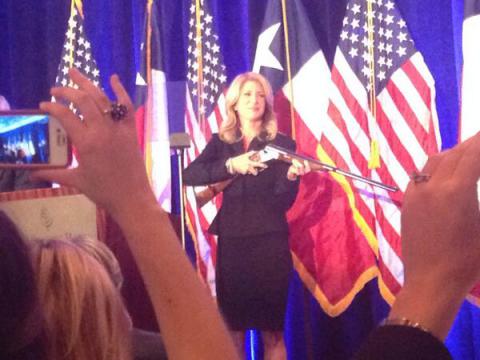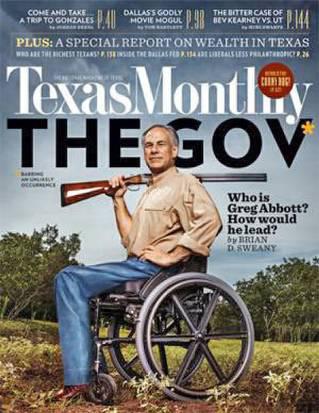Texan Political Photo Ops with Guns

Politicians love a good prop. They pose with everything from babies to tanks. For Texas politicians, a crucial photo op is the one that establishes the subject’s relationship with guns. The benchmark for such pictures is the iconic Annie Leibovitz photo of Ann Richards, above. Richards’ pose is relaxed but alert. She is clearly at home holding her gun, which points diagonally to the ground as she chats with the woman on the left. The black and white image gives a classic dignity to the scene of trees and fields, conveying the impression that the photo dates from the early twentieth century rather than the early 1990s. Richards’ pants, button down shirt, pocketed vest and bandanna tied around the neck create a formal version of the cowboy aesthetic. This image is quite distinctly Texan.
In January, Richards’s son Clark presented Richards’s shotgun to Texas gubernatorial candidate Wendy Davis. Naturally, Davis posed with the gun for a photo op.

While the Richards photo captures what appears to be a candid moment of relaxation during a hunt, Davis is clearly orchestrating this image. She is standing in front of three US and two Texas flags, self-consciously promoting the idea that she is part of Texan and American gun culture. She wears a suit jacket and skirt, an unlikely outfit in which to use a hunting gun. She holds the gun to her left and diagonally downwards, perhaps quoting the Richards image, but the angle is slightly different. Whereas Richards would hit the ground if her gun accidentally went off, Davis’s fire would catch the lower body of whoever was unlucky enough to be standing to her left on the speaking platform. The position of Davis’s arms is angular and tense. She does not seem to have Richards’s natural and easy relationship to her gun.
Davis’s opponent, Greg Abbott, posed with a gun for the cover of Texas Monthly.

Abbott slings the gun casually over his shoulder. Unlike Richards and Davis, he holds the gun in one hand, so that he could not easily fire if he needed to. The gun points horizontally, which could be dangerous, but he appears to have no company but the camera. Like Richards, Abbott is pictured in a field with a background of trees. He wears jeans and a button down shirt, a more realistic hunting outfit than Davis’s suit and somewhat similar to Richards’s dress in her photo. His body is relaxed. Like Davis, he smiles at the camera, more self-conscious than the remote Richards.
Both gubernatorial candidates appear to quote the Richards image in their photo ops. Davis, actually holding a gun that belonged to Richards, mimics the angle of Richards’s gun in the photo. Abbott wears clothing similar to Richards’s and appears against a similar backdrop. The Abbott image is closer to the Richards image in tone, and conveys a comparable sense of comfort with a gun. The Davis image is more artificial and somewhat awkward. It seems to be a less successful use of the Richards imagery.
Some conservative bloggers have taken the awkwardness of the Davis image as evidence for Davis’s failure at being a “badass.” They imply that Davis’s credibility on gun issues is as lacking as her comfort with guns appears to be in the photo. This interpretation shows the risk of such photo ops. The photo can align poorly with the beliefs or abilities the politician is trying to promote. The Davis photo attempts to convey how Texan and gun-friendly Davis is, but it fails because of the staged indoor background, Davis's unhunterly clothing, and her awkward posture, which add up to an unsuccessful attempt to show the same confident relationship with guns that is portrayed in the Richards image. The rhetoric of a photo op can be difficult to control, especially if the politician uses a prop with such powerful associations as a gun.



Add new comment